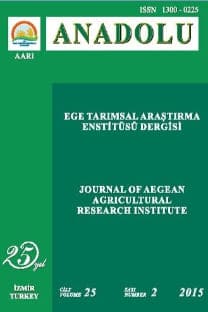Economically Important Wild Mushroom Saffron Milk Cap [Lactarius deliciosus (L.) Gray] of Aegean Region, Turkey
Türkiye - Ege Bölgesi’nde Ekonomik Öneme Sahip Yabani Çıntar Mantarı [Lactarius deliciosus (L.) Gray]
___
- Adanacioglu N., U. Yildiz, E. Ogur, L. Aykas, A. Tan, and T. Taylan. 2016. Türkiye Makromantar Genetik Kaynakları I. Ege Bölgesi. Anadolu, J. of AARI 26 (1): 46-61.
- Anonymous. 2009. Mushrooms. Calu crop production guides. http://www.calu.bangor.ac.uk/.
- Anonymous. 2012. Saffron milk cap (Lactarius deliciosus). http://www.trufflesandmushrooms.co.nz/ Lactariu s%20 deliciosus %20web.pdf.
- Anonymous. 2016. Türkiye İstatistik Kurumu. www.tuik.gov.tr/.
- Barros L, P. Baptista, D. M. Correia, S. Casal, B. Oliveira, I. C.F.R. Ferreira. 2007. Fatty acid and sugar compositions, and nutritional value of five wild edible mushrooms from Northeast Portugal. Food Chemistry 105: 140-145.
- Bernas E., G. Jaworska, Z. Lisiewska. 2006. Edible Mushrooms as a source of Valuable Nutritive Constituents. Acta Sci. Pol. Tech. Aliment 5 (1): 5-20.
- Breene W. M. 1990. Nutritional and medicinal value of specialty mushrooms. J. Food Prod. 53 (10): 883–894.
- Cemeroğlu, B. 2010. Gıda analizleri (Food Analysis). Nobel Yayın Dağıtım, Ankara, 682 p.
- Chang S. T., and P. G. Miles. 2004. Mushrooms Cultivation, Nutritional Value, Medicinal Effect, and Environmental Impact. 2nd edition. 477 pp. CRC press US.
- Colak, A., Faiz, Ö., Sesli, E., 2009. Nutritional Composition of some wild edible mushrooms. Türk Biyokimya Dergisi-Turkish J. of Biochemistry 34 (1): 25-31.
- De Frutos, P., Martínez Pena, F., Esteban Laleona, S., 2008. Propuesta de ordenación comercial de los aprovechamientos micológicos a través de lonjas agrarias: análisis económico y financiero para la provincia de Soria. Revista Espanola de Estudios Agrosociales y Pesqueros 217: 73–103.
- Gökmen V, N., Kahraman, N., Demir, J. Acar. 2000. Enzymatically validated liquid chromatographic method for the determination of ascorbic and dehydroascorbic acids in fruit and vegetables. J Chromatogr A 881: 309-316.
- Guillamón, E., A. García-Lafuente, M. Lozano, M., D´Arrigo, M.A. Rostagno, A. Villares, J.A. Martínez. 2010. Edible mushrooms: Role in the prevention of cardiovascular diseases. Fitoterapia 81: 715-723.
- Jong, S. C. 2005. The Market Potential for Medicinal Mushrooms. www.mushworld. com.
- Kalac, P. 2013. A review of chemical composition and nutritional value of wild-growing and cultivated mushrooms. J. Sci. Food Agric. 93 (2): 209-218. Doi: 10.1002/jsfa.5960. Epub 2012 Nov 21.
- Lahely S, M, Bergaentzle, C., and Hasselmann. 1999. Fluorimetric determination of niacin in foods by highperformance liquid chromatography with post-column derivatization. Food Chem. 65: 129-133.
- Latimer G.W. 2012. Official Methods of Analysis of AOAC International. AOAC International.
- Lincoff, G.H. 2009. Field guide to mushrooms. Knopf, Boroi Books, Chanticleer Press, Inc., New York. 926 p.
- Manzi, P., L. Gambelli, S. Marconi, V. Vivanti, L. Pizzoferrato. 1999. Nutrients in edible mushrooms: An interspecies comparative study. Food Chem. 65: 477-482.
- Mattila, P., K. Könkö, M. Eurola, J.-M. Pihlava, J. Astola, L.Vahteristo, V. Hietaniemi, J. Kumpulainen, M. Valtonen, V. Piironen. 2001. Contents of vitamins, mineral elements, and some phenolic compounds in cultivated mushrooms. J. Agric. Food Chem. 49: 2343-2348.
- Onbasili, D., G. Yuvali Çelik, H. Katircioğlu , İ. Narin. 2015. Antimicrobial, Antioxidant Activities and Chemical Composition of Lactarius deliciosus (L.) Collected from Kastamonu Province of Turkey. Kastamonu Üni., Orman Fakültesi Dergisi 15 (1): 98-103.
- Ozturk M., M. E. Duru, Ş. Kivrak, N. Mercan-Doğan, A. Türkoğlu and M.A. Özler. 2011. In vitro antioxidant, anticholinesterase and antimicrobial activity studies on three Agaricus species with fatty acid compositions and iron contents: A comparative study on the three most edible mushrooms, Food Chem Toxicol. 49: 1353-1360.
- Ozturk, M., G., Tel, F. A., Öztürk, M. E., Duru. 2014. The cooking effect on two edible mushrooms in Anatolia: Fatty acid composition, total bioactive compounds, antioxidant and anticholinesterase activities. Rec. Nat. Prod. 8 (2): 189-194.
- Pekşen, A., and H. Akdeniz. 2012. Organik Ürün Olarak Doğa Mantarları. Ormancılık dergisi. 8: 34-40. http://www. of.duzce.edu.tr.
- Pushpa, H. and K. B. Purushothoma. 2010. Nutritional Analysis of Wild and Cultivated Edible Medicinal Mushrooms. World Journal of Diary and Food Sciences 5: 140-144.
- Reis, FS, L., Barros, A., Martins , IC, Ferreira.2012. Chemical composition and nutritional value of the most widely appreciated cultivated mushrooms: an inter-species comparative study. Food Chem Toxicol. 50 (2): 191-7.
- Solak, M. H., M. Işıloğlu, E. Kalmış, H. Allı. 2015. Macrofungi of Turkey, Checklist Volume II, Üniversiteliler Ofset, Bornova, İzmir.
- Wani, B. A., R. H. Bodha and A. H. Wani. 2010. Nutritional and medicinal importance of mushrooms. Journal of Medicinal Plants Research Vol. 4 (24): 2598
- ISSN: 1300-0225
- Yayın Aralığı: 2
- Başlangıç: 1991
- Yayıncı: Ege Tarımsal Araştırma Enstitüsü
Beslenme ve Gıda için Biyoçeşitlilik: Ege Bölgesi’nin Yenilebilir Yabani Bitki Türleri
Ayfer TAN, Nese ADANACIOGLU, Sevinc KARABAK, Lerzan AYKAS, Necla TAS, Tefik TAYLAN
Yabani Yenilebilir Meyveler: Zengin Biyolojik Çeşitlilik Kaynağı
Sezai ERCISLI, Halil IBRAHİM SAGBAS
Adel M ELMAGHABI, Salem HAMMUD, Elmunder ABUGNIA
Saadet TUGRUL AY, Ahu CINAR, Fırat AYAS, Kadriye YUKSEL, Orcun CINAR, Sevinc KARABAK
Fırat AYAS, Fatih Alpay VURAN, Kadriye YUKSEL, Orçun ÇINAR, Saadet TUĞRUL AY, Sevinç KARABAK
Neşe ADANACIOĞLU, Ayfer TAN, Sevinç KARABAK, Nurcan GUZELSOY, Fırat AYAS, Lerzan AYKAS, Tefik TAYLAN
Ayfer TAN, Neşe ADANACIOĞLU, Sevinç KARABAK, Nurcan AYSAR, Ahmet Şemsettin TAN, Lerzan AYKAS
Gıda ve Beslenme için Biyoçeşitlilik Projesi: Karadeniz Bölgesi Çalışmaları
Kursad OZBEK, Sevinc KARABAK, Nurcan AYSAR GUZELSOY, Nurgul SARI, Rukiye MURAT DURAN, Rahmi TASCI, Birgul GUNER, Hilal YUCEARSLAN, Durmus DENIZ, Ahmet AKSOY
Biodiversity for Food and Nutrition Project: Black Sea Region Studies
Kürşad ÖZBEK, Sevinç KARABAK, Nurcan AYSAR GUZELSOY, Nurgül SARI, Rukiye MURAT DURAN, Rahmi TAŞCI, Birgul GUNER, Hilal YUCEARSLAN, Durmus DENIZ, Ahmet AKSOY
Ahu CINAR, Saadet TUĞRUL AY, Fırat AYAS, Sevinç KARABAK, Nurcan GUZELSOY, Ozgul UCURUM
